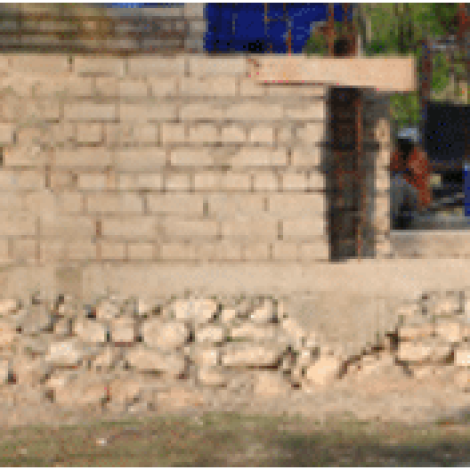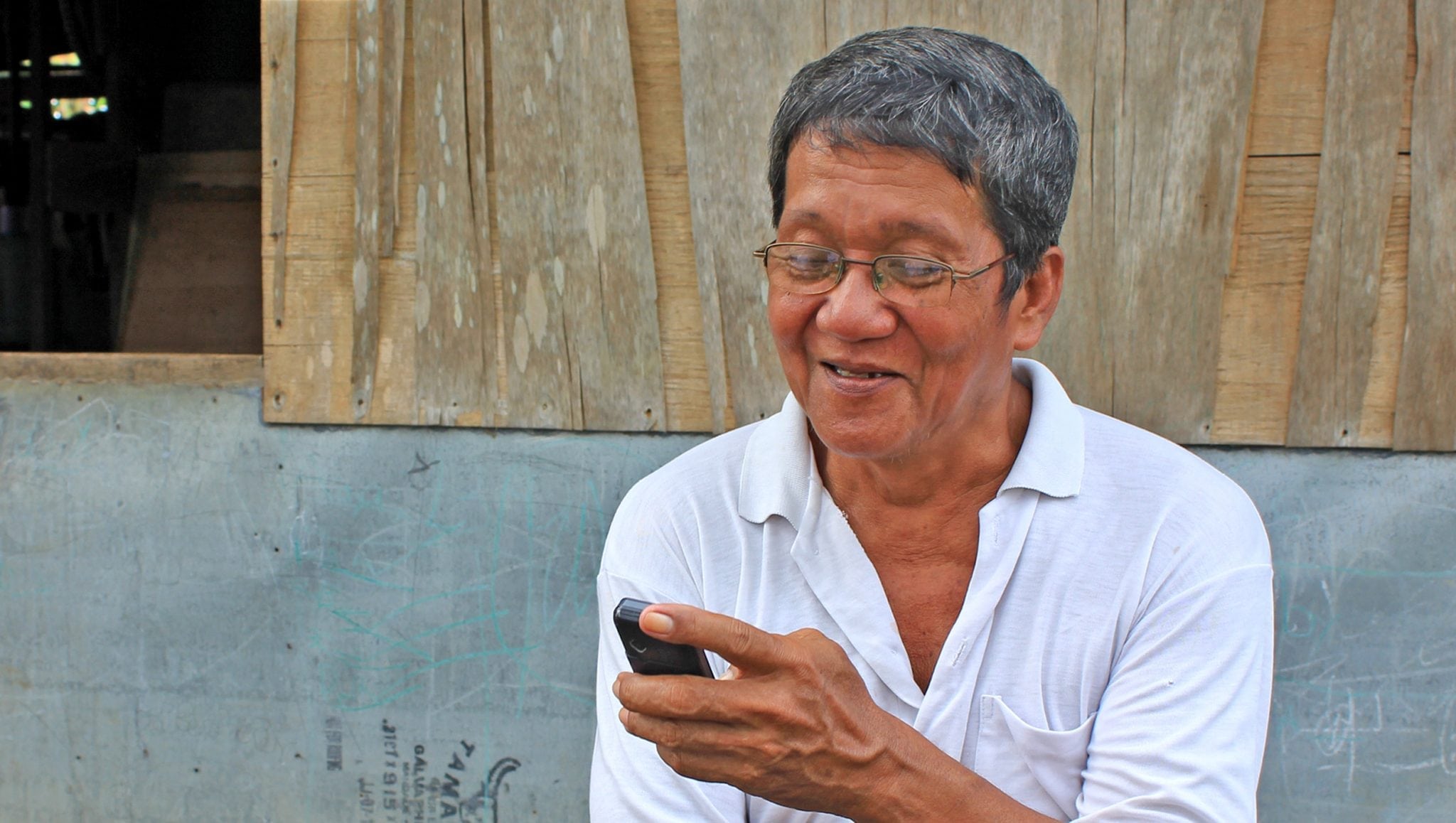Jim Hallock is teaching his compressed-earth block building techniques to people in Deslandes, Haiti to help them build a school. Earthen block construction can be earthquake resistant, waterproof, durable and cheap.
Jim Hallock is passionate about dirt.
To hear him talk about it, dirt, as compressed-earth blocks, has nearly miraculous potential. The right kind of dirt, with just enough clay—but not too much—can build homes and cities that are energy efficient, durable and even beautiful, he says. He travels around the world teaching the art of earthen construction. And he would like to teach you to build with it, too.
Hallock isn’t alone in his passion, of course. Already about half of the world’s buildings are made from earth [eartharchitecture.org]. It’s one of the oldest and most abundant construction materials we have. About 65 percent of the world’s soil is suitable for construction, Hallock says. And it’s cheap. Earthen blocks are only a little more expensive than, well, dirt.
In spite of that weight of history, precedent and price, however, some of the people who could benefit most from earthen construction do not know about it. Hallock is working to change that.
Hallock has taught sustainable construction techniques in Zambia, Haiti, Latin America, the United States and elsewhere. Now, he is offering a series of workshops in May and June this year in Texas and Mexico (pdf).
Earth and Lime Institute
Rather than traveling worldwide to teach the basics of earthen construction, as he has done in the past, Hallock figured it would be more efficient to invite people from around the world to train with him in a central location. So, he founded the Insituto Tierra y Cal on 23 acres of land outside of San Miguel de Allende, Mexico. San Miguel is a colonial city in the temperate mountain highlands of central Mexico with weather that evokes about as much of Hallock’s praise as compressed earth blocks themselves.
There, and also in the United States, Hallock has offered workshops on earthen construction for the past five years. The institute is expanding, adding new training workshops in sustainable agriculture and possibly other topics later.
Hallock has partnered with the Mexican chapter of Engineers Without Borders and the International Center for Appropriate Technologies and Indigenous Sustainability (iCATIS), based in Arvada, Colo. to form a regional CATIS in San Miguel.
Construction on the institute’s grounds is underway. When the CATIS is finished, it aims to showcase a range of sustainable technologies and how they work together. In the meantime, Hallock and other experts are teaching their craft to people in neighboring farms and villages, Haiti, the United States and other countries.
Workshops: Topics and schedules
Hallock has teamed with other experts to offer a survery workshop on compressed-earth blocks in May in the United States, and a month of in-depth workshops and a building practicum on construction, land management and agriculture for developing countries. The cost is $625 per week, $525 for those who register by April 25. Scholarships are available. The schedule follows:
May 26-28, 2011 (San Antonio, Texas): Hallock has teamed with the US
building company Advanced Earth Construction Technologies to teach a three-day survey course in San Antonio, Texas on earth block construction, lime stabilization and natural plasters. Students will learn about soil selection, block manufacturing, block-making machinery, wall-stacking techniques and natural plasters. Get more information here (pdf).
June 5-11, 2011 (San Miguel de Allende, Mexico): Hallock and his colleagues will present a thin shell concrete roof and natural plasters workshop. Students will learn to find local materials and build a thin-shell concrete structure for the CATIS. Get more information here (pdf).
June 13-17, 2011: This five-day survery course in earth-block construction will give students the basic knowledge and practice they’ll need to build structures. It’s a precursor to the two-week construction project on the CATIS laboratory. Get more information here (pdf).
June 20-24 and June 27-July 1: During a two week construction practicum, students will build the laboratory of the CATIS main campus building. They will build walls, learn to waterproof and reinforce for earthquake resistance, install plumbing and electrical wiring, build doors, windows, arches, lintels, bond beams domes and vault-style roofs. Get more information here (pdf).
June 6-10: A workshop series in sustainable agriculture for the developing world takes place in tandem with the earthen construction. Students may have chances to drift between the two workshops to pick up skills that interest them, Hallock says. A team of agriculture experts will lead this series that starts with applied landscape water harvesting and agro-ecosytem development. Participants will learn to harvest runoff and assess watersheds with an eye toward restoration and irrigation, among other skills. Get more information here (pdf).
June 13-17: Making More with Microbes – Soil Microbiology for Regenerative Agriculture. Participants will learn the basics of composting and soil microbiology to improve a land’s fertility. Get more information here (pdf).
June 20-24: Garden and Small-Scale Farming in Rural and Urban Locales in the Developing World. Participants will learn about issues in organic gardening and farming, composting and clay-pot watering techniques and other skills. Get more informationhere (pdf).
June 27-July 1: Holistic Management – Using grazing animals to regenerate lands in the developing world. Participants can bring maps of their land to develop a comprehensive management plan. The workshop teaches techniques to improve land quality, increase yields and conserve the land’s health for future generations. Get more information here (pdf).
Resources
CATIS general information, partners and contacts (pdf)
Instituto Tierra y Cal
iCATIS

This model shows the planned campus of the Center for Appropriate Technologies and Indigenous Sustainability at the Instituto Tierra y Cal in San Miguel de Allende, Mexico.


Compressed earth walls for those in poverty largely ignore that most in poverty are not without work and sitting idly all day. Compressed earth walls take a lot of time/labor to build, and require concrete a seen in the buttresses, post details, plastering and roof in the above mock up. Why bother with all the dirt? Just cast thinly and use concrete! Your mock up reminds me of a guy with a poor idea and he keeps re-inventing it when it is shown to be in error. Inventor inertia or “I have a great idea but it just needs fine tuning” is a very hard force to overcome. Bob, imagine a house cast in concrete where nearly all of it is under 2″ thick (walls, roof footing). This house would use the same amount of concrete as yours but without the dirt, it’s weight, or its labor.